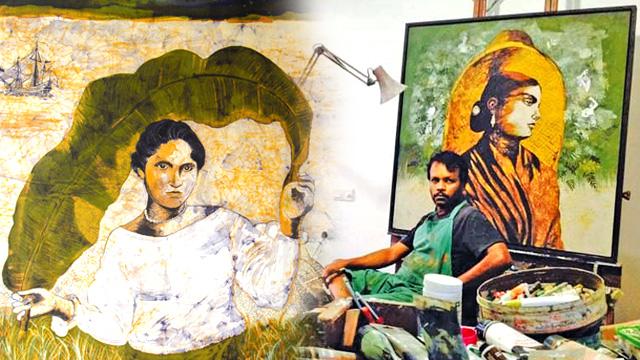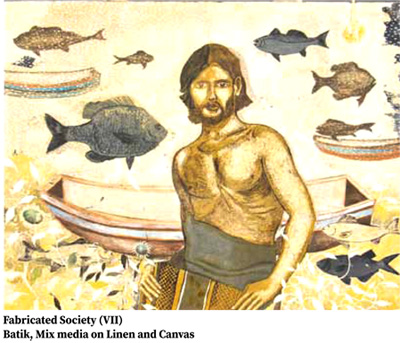
 ‘Hear her
‘Hear her
The queen
enchanting, alluring
yearning, waiting,
weaving her world
with the colours of her land
the thread of her cocoon
She twirls
pulls
severs
for freedom…’
These were the first few lines of the poem ‘Kuveni’s Rhapsody’ which I wrote over a decade ago. I found myself recalling these words as I walked through the Barefoot Gallery, viewing the paintings of the exhibition ‘Fabricated Society’ by Chamila Gamage. I quickly realised that the collection was very different to any of Chamila's earlier work or to anyone else’s paintings I have seen. The art resembled woven tapestry more than painted canvases. There was something ancient and traditional about them but they were also talking to a contemporary audience in a mysterious language of symbols and cryptic messages.
Just as our fore-mother, Queen Kuveni may have weaved her fabric and with that the story of our land, Chamila too has used woven fabric to tell his story of what he sees as ‘who we are’.
‘I feel that this country is what it is, because of our rich cultural diversity. We are who we are because of this blend of differences among individuals and communities. This little island is so rich and beautiful because of all her children: those from the fishing communities in the coastal areas to the plantation workers of the tea estates.
I have tried to represent all these groups of people who come from every nook and corner of the island. In this exhibition ‘Fabricated Society’ they have been brought together to tell their own unique story while maintaining certain commonalities and harmony. With each portrait, I have used symbols to convey their yarns and tales.’ Explains Chamila.
The figures used in Chamila’s earlier work had been generalized, simplified human forms which indicated the whole of humanity as opposed to individuals with specific characteristics. In his current work, the viewer could identify the back story of each person represented. Chamila seems to have somewhat departed from his earlier critique of social issues and arrived at a place where togetherness is yearned and valued. Though each portrait is different, there is something which binds all those who are peering from the frames.
 ‘It was while I was pondering on this new concept that the pandemic struck. The lockdowns literally forced us to be isolated from our communities and society. We were compelled to be with our families, and I saw this as an opportunity to form a small artistic circle within the family group.
‘It was while I was pondering on this new concept that the pandemic struck. The lockdowns literally forced us to be isolated from our communities and society. We were compelled to be with our families, and I saw this as an opportunity to form a small artistic circle within the family group.
I thought of ways to bring the family members together to work on a large scale artistic project. As an artist who is accustomed to painting and sculpting on his own, I challenged myself to come up with innovative techniques. I started to study fabric art forms: especially diverse batik techniques which are used in different countries.
Globally, I could find only one artist who had used Batik as a technique for contemporary art. But even those works had been done using only two colours. So I decided to experiment with multiple colours and Batik techniques from Asia as well as Africa. Once I decided on the technical journey, it was clear to me that I could involve my family for the process. My entire family participated by waxing, dying and boiling the fabric.
 Although we were supposed to be socially isolated, we came together in our little world to create something wonderful. Many see the adversity and the negativity caused by the pandemic, I see the positivity and the profound connections I was able to form.’ Chamila goes on to describe his experience.
Although we were supposed to be socially isolated, we came together in our little world to create something wonderful. Many see the adversity and the negativity caused by the pandemic, I see the positivity and the profound connections I was able to form.’ Chamila goes on to describe his experience.
Against the backdrop of intricate traditional patterns and the colours of Batik, are symbols reminiscent of Egyptian hieroglyphs and random words in many languages. Against those are the main figures in their distinctive attire and adornment which are tell-tale of where they come from: a woman from the ‘ahikuntika’or the gypsy tribe, a Kandyan upper-class lady, a man from Jaffna, and so many others.
At times they exuberate opulence with the gold leafed motifs; at times they disturb us with their questioning dispositions. They seem to be the masters and mistresses of this world, this little country which we hold dear.
Those who may have lived or are still living unassuming, quiet lives or those who may have been persecuted and silenced have been given a voice: a voice of power and authority by an artist whose journey is founded on questioning the world.
‘Although my main intention was to highlight the cultural diversity of Sri Lanka, I also wanted to question the class system and the caste systems which still prevail. It could be possible that the extent of it which affects us may have changed over time, but I feel there are unspoken, unwritten rules which still dictate how one should live his or her life.
Most of the time these issues are the ‘elephant in the room’. I suppose I have made that ‘elephant’ more visible through this collection’ says the artist.
As I went past each story teller, each of those painted persons who would look at me with eyes of wonder or resignation, I could not help but think about my own belongingness to this beautiful island. I thought about all those who have come before me, who may have had shed silent tears, blood and sweat so that I could call this little piece of heaven, ‘home’. Chamila Gamage’s ‘Fabricated Society’ is not just about dyed, waxed and painted fabric: it is about our inter woven heart strings and entangled thread which binds us together to face war, famine or even an unprecedented, incomprehensible pandemic.
(Fabricated Society could be viwed at the Barefoot Gallery from the December 17, 2021 to January 16, 2022)
Pictures by: Ruwan Meegammana
